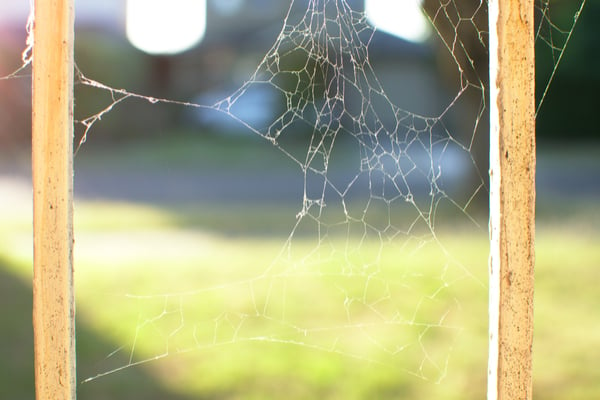Common Landscape Spiders

BEHAVIOR & APPEARANCE
Spiders are arthropods that belong to the class Arachnida and order Araneae. They have two body regions: the cephalothorax (head fused with thorax) and abdomen (saclike and unsegmented). Spiders have 8 legs, jaws (chelicerae), a pair of feeler-like pedipalps, and either 8 eyes or 6.
There are over 3,400 species of spider in North America. We’ve divided the spiders you’re most likely to encounter on landscaping into four broad categories. Here’s what you need to know about each:
GARDEN SPIDERS
Garden spiders and other orb weavers typically measure ⅕ to 1 inch long and have a leg span of ½ inch to 2½ inches. Of the 3,500 species of garden spiders, about 180 species are found in the US and Canada. Most species are yellowish-brown or pale gray with darker brown and whitish markings. Some species may have yellow, orange, pink or red abdomens with white and/or black markings instead.
Adult female garden spiders have very large, rounded abdomens partially covering their cephalothorax. Their legs usually have bands of light and dark colors, and they’re sparsely covered with short spines. Males look similar to females, but they’re much smaller. All garden spiders have eight, small eyes. The side-facing (anterior and posterior lateral) eyes are closely paired. The four central eyes (anterior and posterior median) are arranged in a square. Females construct characteristic orb webs.
WOODLOUSE HUNTERS
Woodlouse hunter spiders typically measure ½ inch long. The males and females are similar in size and coloration. They have 6 eyes, all of which are small and closely grouped. Their cephalothorax and legs are glossy red, and their abdomens are dirty white or beige colored.
Woodlouse hunter spiders may live indoors, on floors, along foundation walls, at ground level, or in garages. Usually, people find woodlouses under stones, logs, landscaping timbers, and other materials that contact with the ground. They also commonly sneak into the deep crevices formed between soil and mulch and building foundations. Woodlouse spider biters are about as painful and dangerous as bee stings.
JUMPING SPIDERS
Jumping spiders are about ⅛ to ¾” long. They are robust and compact with relatively short, stocky legs. The front pair of a jumping spider’s legs are often thicker and somewhat longer than their other legs. Both the body and legs have a velvety or hairy appearance. Different species of jumping spiders come in a wide variety of different colors. Some are black, brown, or grey with spots, patches, patterns, or stripes of other colors. Some jumping spiders have distinctively iridescent jaws and “faces.”
Unlike most other spiders, jumping spiders usually have excellent color and detail vision. Their front-middle pair of eyes are very large, while the front-outer set of eyes are somewhat smaller. The four remaining eyes are all even smaller than the front-outer set. Jumping spiders very rarely bite humans. Their bites aren’t dangerous, though they may sting or hurt about as much as a bee sting.
WOLF SPIDERS
Wolf spiders range widely in adult body length from ¼ to 1 ⅜” long. Their legs are usually longer, measuring around 1 to 3” long. Both the body and legs of wolf spiders tend to be velvety or hairy. They may be yellowish-brown with darker brown and white markings, gray and brown, or nearly solid dark brown. The top middle pair of all wolf spiders’ eight pairs of eyes are much larger than their other 6.
Wolf spiders have fair vision and hunt actively. They’re mostly nocturnal and rest under logs, leaf litter, burrows, or crevices during the day. Females are slightly larger than males. Female wolf spiders are highly maternal, and carry newly hatched spiderlings on their bodies until the young can fend for themselves. Wolf spiders usually live in the basements and garages of homes and buildings. They’re particularly common in wooded areas. Wolf spiders don’t bite very often, but their jaws are large enough that their bites may be painful. Fortunately, Wolf spider venom is mild and presents no serious threat to humans.
PROFESSIONAL CONTROL
First, our technicians apply a residual liquid insecticide barrier treatment around your building foundation’s outer perimeter. We apply this treatment to lower siding, eaves and porticos, exterior molding/trim, thresholds, patios, and decks. We’ll also cover sheds and other outbuildings for maximum protection. In some cases, we may also treat mulch and landscaping features near your building.
If we discover a large spider population or particularly conducive conditions for spiders on your property, then we may recommend HomeGuard program for comprehensive year-round protection.

Get A Free Estimate Today!
CONTROL AND PREVENTION
You can notably reduce the number of spiders around your landscape in a number of ways:
- Prune tree and shrub branches away from building surfaces to prevent bridging.
- Eliminate tall and dense vegetation (like vines, juniper bushes, uncut grass, and weeds) that’s growing close to the foundation.
- Replace white exterior lighting with amber-colored lamps to reduce the number of prey insects attracted to your home.
- Excluding gaps under doors by replacing or adding door sweeps.
- Lower courses of siding with silicone sealer.
- Seal off gaps around utility penetrations using builder’s putty.
- Plug up weep holes in brick veneer by filling them in with copper gauze.
- Capture wandering spiders by placing sticky traps indoors along walls, especially behind appliances and heat-producing fixtures.
- Remove spiders and webs using a shop vacuum cleaner or household vacuum fitted with a hose attachment.






